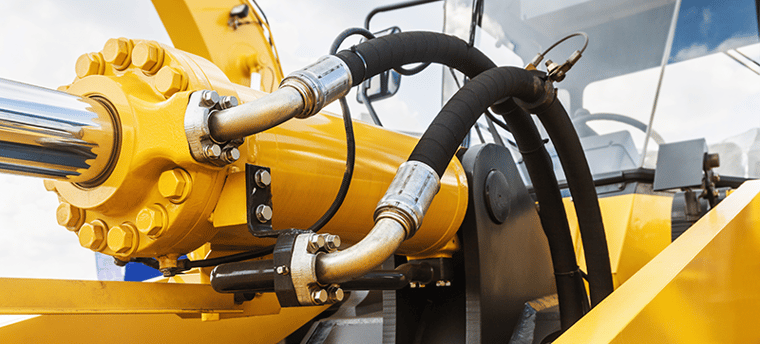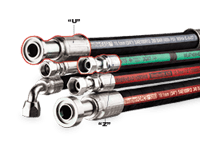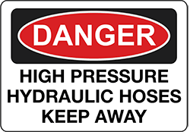Hydraulic hose assemblies are used in many applications, but no matter the job, they carry fluids under extreme pressure to provide power to operate equipment. From the truck on the highway to the rollercoaster ride at your favorite amusement park, hydraulics help safely operate, control, and power many types of equipment.
To be effective, and safe, a hydraulic assembly must include the correct hose for the application that meets pressure requirements and flow capacity. It also must have the correct fittings for the hose being used and proper installation of the fittings onto the hose. Fittings can be installed either by crimping (as in most of hydraulic hose applications) or by installation of a screw-on hose end.
To be effective, and safe, a hydraulic assembly must include the correct hose for the application that meets pressure requirements and flow capacity. It also must have the correct fittings for the hose being used and proper installation of the fittings onto the hose. Fittings can be installed either by crimping (as in most of hydraulic hose applications) or by installation of a screw-on hose end.
HOSE
Most hydraulic systems start with the hose, although there are applications where metal tubing may be used instead. While there are many different types of hoses on the market, there are a few key things that will help determine the type of hose you need.
NOTE: Keep in mind that in maintenance applications, you typically need to replace a hose with one of the same specification—which can be identified by an SAE or DIN number on the lay line of the hose:
- Size: Determining what size hose you need is a key element to selecting the proper hose. Hose comes in different diameters. Using a large diameter will increase cost, and since many larger diameter hoses have lower operating pressure capability, it could result in an assembly that might not handle the pressure in the system. Conversely, using a small diameter hose can reduce flow and hamper operational efficiency of the equipment.

- Temperature: Take into consideration both the temperature outside of the hose and of the fluids flowing through it to determine the best hose for your equipment. The latter can have the greatest effect on hose life.
- Application: What type of equipment is being used? In what environment is it being used? Does the hose need to be DOT approved? For example, if you work in excavation, you might need an abrasion resistant hose, or if you have trucks, you might need DOT to be compliant.
Once again, stay with the original specification on the hose the equipment came with. However, its never too late to upgrade the hose selection to an abrasion resistant version of the original hose. It's a particularly good idea if abrasion resulted in failure of the original hose. - Media: What type of fluid will be running through the hose? The hose you use must be compatible with the media being conveyed.
- Pressure: What is the working pressure needed for the hose?
FITTINGS
 Once you have identified the hose you can select the fittings. Remember the hose dictates what series of fittings can be used (ie. “U” vs. “Z”). "Z" series fittings are higher pressure fittings that have "teeth" that bite into the wire reinforcement of the hose. The "U" series fittings also can be high pressure, but lack the "teeth" feature of the "Z" fitting. The application of the assembly will determine the style of the hose ends needed (elbows, straights, flange, male pipe, etc.)
Once you have identified the hose you can select the fittings. Remember the hose dictates what series of fittings can be used (ie. “U” vs. “Z”). "Z" series fittings are higher pressure fittings that have "teeth" that bite into the wire reinforcement of the hose. The "U" series fittings also can be high pressure, but lack the "teeth" feature of the "Z" fitting. The application of the assembly will determine the style of the hose ends needed (elbows, straights, flange, male pipe, etc.)CRIMPERS
Once you have identified the hose and fittings, it’s time to decide on the proper crimper (unless you will be using screw-on hose ends). The following questions can help you narrow your search:
- Do you need a portable or stationary unit?
- What is your power source?
- 110 volt? 220 volt? Air/Hydraulic?
- 110 volt? 220 volt? Air/Hydraulic?
- What capacity does the crimper need to be able to accommodate?
- 1, 2, 4, or 6 wire hoses?
- What diameters of hose will you be using?
Be sure to get the proper crimp specifications for the hose and crimper you are using. Calipers also are necessary to measure the crimp diameters of the fittings once the hose assembly has been crimped.
Lastly, remember safety is most important. Safety glasses always should be worn and proper training on the use of the crimper is highly recommended. Without the correct hose, fittings, and proper crimp; failure is possible, and could result in injury, property damage, or worse.
.png?width=131&height=58&name=image%20(40).png)

